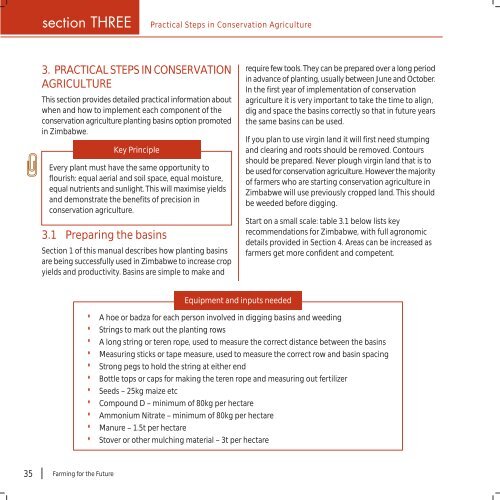A Guide to Conservation Agriculture in Zimbabwe - Canadian ...
A Guide to Conservation Agriculture in Zimbabwe - Canadian ...
A Guide to Conservation Agriculture in Zimbabwe - Canadian ...
You also want an ePaper? Increase the reach of your titles
YUMPU automatically turns print PDFs into web optimized ePapers that Google loves.
section THREE<br />
Practical Steps <strong>in</strong> <strong>Conservation</strong> <strong>Agriculture</strong><br />
3. PRACTICAL STEPS IN CONSERVATION<br />
AGRICULTURE<br />
This section provides detailed practical <strong>in</strong>formation about<br />
when and how <strong>to</strong> implement each component of the<br />
conservation agriculture plant<strong>in</strong>g bas<strong>in</strong>s option promoted<br />
<strong>in</strong> <strong>Zimbabwe</strong>.<br />
Key Pr<strong>in</strong>ciple<br />
Every plant must have the same opportunity <strong>to</strong><br />
flourish: equal aerial and soil space, equal moisture,<br />
equal nutrients and sunlight. This will maximise yields<br />
and demonstrate the benefits of precision <strong>in</strong><br />
conservation agriculture.<br />
3.1 Prepar<strong>in</strong>g the bas<strong>in</strong>s<br />
Section 1 of this manual describes how plant<strong>in</strong>g bas<strong>in</strong>s<br />
are be<strong>in</strong>g successfully used <strong>in</strong> <strong>Zimbabwe</strong> <strong>to</strong> <strong>in</strong>crease crop<br />
yields and productivity. Bas<strong>in</strong>s are simple <strong>to</strong> make and<br />
require few <strong>to</strong>ols. They can be prepared over a long period<br />
<strong>in</strong> advance of plant<strong>in</strong>g, usually between June and Oc<strong>to</strong>ber.<br />
In the first year of implementation of conservation<br />
agriculture it is very important <strong>to</strong> take the time <strong>to</strong> align,<br />
dig and space the bas<strong>in</strong>s correctly so that <strong>in</strong> future years<br />
the same bas<strong>in</strong>s can be used.<br />
If you plan <strong>to</strong> use virg<strong>in</strong> land it will first need stump<strong>in</strong>g<br />
and clear<strong>in</strong>g and roots should be removed. Con<strong>to</strong>urs<br />
should be prepared. Never plough virg<strong>in</strong> land that is <strong>to</strong><br />
be used for conservation agriculture. However the majority<br />
of farmers who are start<strong>in</strong>g conservation agriculture <strong>in</strong><br />
<strong>Zimbabwe</strong> will use previously cropped land. This should<br />
be weeded before digg<strong>in</strong>g.<br />
Start on a small scale: table 3.1 below lists key<br />
recommendations for <strong>Zimbabwe</strong>, with full agronomic<br />
details provided <strong>in</strong> Section 4. Areas can be <strong>in</strong>creased as<br />
farmers get more confident and competent.<br />
Equipment and <strong>in</strong>puts needed<br />
• A hoe or badza for each person <strong>in</strong>volved <strong>in</strong> digg<strong>in</strong>g bas<strong>in</strong>s and weed<strong>in</strong>g<br />
• Str<strong>in</strong>gs <strong>to</strong> mark out the plant<strong>in</strong>g rows<br />
• A long str<strong>in</strong>g or teren rope, used <strong>to</strong> measure the correct distance between the bas<strong>in</strong>s<br />
• Measur<strong>in</strong>g sticks or tape measure, used <strong>to</strong> measure the correct row and bas<strong>in</strong> spac<strong>in</strong>g<br />
• Strong pegs <strong>to</strong> hold the str<strong>in</strong>g at either end<br />
• Bottle <strong>to</strong>ps or caps for mak<strong>in</strong>g the teren rope and measur<strong>in</strong>g out fertilizer<br />
• Seeds – 25kg maize etc<br />
• Compound D – m<strong>in</strong>imum of 80kg per hectare<br />
• Ammonium Nitrate – m<strong>in</strong>imum of 80kg per hectare<br />
• Manure – 1.5t per hectare<br />
• S<strong>to</strong>ver or other mulch<strong>in</strong>g material – 3t per hectare<br />
35 Farm<strong>in</strong>g for the Future
















